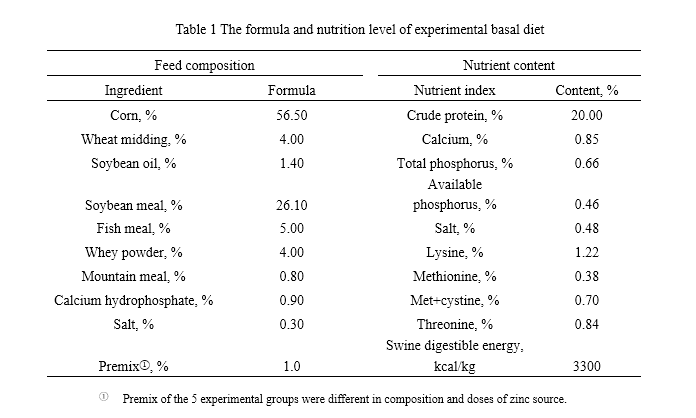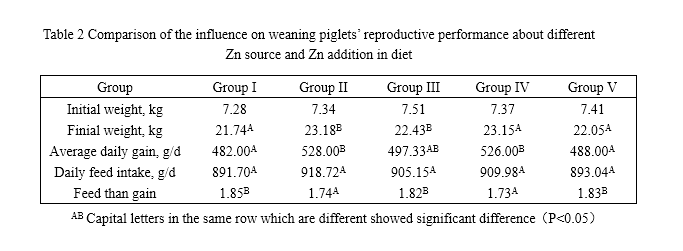Summary: A randomized block design experiment was conducted with 160 crossbred (Duroc × Landrace × Yorkshire) pigs (80 males and 80 females), 32 pigs (16 of each sex) were assigned to each treatment, and treatment groups were assigned randomly to pens in 5 replications. 5 treatment groups all used corn and soybean meal diet which were the same except the additive amount and form of iron. Group I added zinc that of the form of zinc sulfate monohydrate 130mg/kg. Group II added zinc that of the form of zinc methionine chelate 130mg/kg. Group III added zinc that of the form of zinc methionine chelate 65mg/kg. Group IV added zinc that of the form of zinc glycine chelate 130mg/kg. Group V added zinc that of the form of zinc glycine chelate 65mg/kg. The results showed that Group II and Group IV equally instead of Group I could improve the daily gain of piglets and reduce feed than gain. The weight increasing effect on piglets of Group III and Group V was close to Group II and Group IV.
Key words: zinc glycine chelate; zinc methionine chelate; zinc sulfate monohydrate; weaning piglets
Zinc is one of the necessary trace elements to animals, which is a component or activating agent of body’s multiple enzymes, participates in a variety of biochemical reactions. It can enhance animals’ immunity, promote growth and the ability to reproduce. Although Zn has been used widely in piglets’ breeding, it brings great harm to the environment because the body’s absorption and utilization of zinc is different and the difference of different source of zinc is very big. So, it is particularly important to use zinc additives of higher biological value to give full play to breeding potential of livestock and poultry and reduce environmental pollution.
Zinc methionine chelate and zinc glycine chelate are the third generation of new trace elements feed additives which have the characteristics of high biological utilization rate, good palatability and promoting animals’ immune function. In recent years, they get a great development in application in feed industry. The purpose of this study is to compare the using effects of zinc methionine chelate, zinc glycine chelate and zinc sulfate in feed of piglets, so as to provide the reference of choice of zinc source for piglets.
1. Materials and Methods
1.1 Experimental animals and groups
A randomized block design experiment was conducted with 160 crossbred (Duroc × Landrace × Yorkshire) pigs (80 males and 80 females), 32 pigs (16 of each sex) were assigned to each treatment, and treatment groups were assigned randomly to pens in 4 replications. There were 5 experimental groups total. Feeding 5 kinds of experiment diet respectively.
1.2 Experimental diet
The experiment was divided into 5 groups. The basal diet was completely the same except the different form or addition of zinc source (Table 1). Group of zinc sulfate (Group I for short), total content group of zinc methionine chelate (Group II for short), half content group of zinc methionine chelate (Group III for short), total content group of zinc glycine chelate (Group IV for short), half content group of zinc glycine chelate(Group V for short). And feeding 5 kinds of test diet respectively. As the basal diet exactly the same (Table 1). All kinds of test feed were pressed for granular material.
Experimental basal diet: Group I added zinc that of the form of zinc sulfate monohydrate 130mg/kg, Group II added zinc that of the form of methionine 130mg/kg, Group III added zinc that of the form of methionine 65mg/kg, Group IV added zinc that of the form of glycine 130mg/kg. Group V added zinc that of the form of glycine 65mg/kg.
1.3 Experimental materials
Zinc glycine chelate, Zinc methionine chelate: Produced by Wuhan Pharma Chemical Co., Ltd.
Zinc sulfate monohydrate: Bought in the market.
1.4 Raising management
The experimental period were total 35 days. Pilot test were 5 days. Formal test were 30 days. Experimental pigs were raised in the same nursery and web high bed of the same toward. They could be free to feed themselves and drink. Immune and raise procedures according to conventional piggery.
Preparing work finished in the day before the afternoon of piglets’ pilot test. Gave each group corresponding test feed the next morning. Fasting weighted, calculated feed and began to test in the morning of formal period.
Experimental boar had already castrated.
1.5 Experimental index
Average daily gain. Average feed intake. Feed than gain.
The morning of experimental beginning and finishing, fasting weighted piglets one by one. Calculated each daily gain and then calculated each group of piglets’ average daily gain.
Recorded feed consumption for the unit to the fence during the test. Calculated each fence’s feed intake and then calculated each group of piglets’ average daily gain.
Feed than gain (F/G) = feed consumption /weight gain.
1.6 Statistical analysis
After initial handling of experimental data by Excel, used software SPSS12.0 to variance analysis.
2. Results and Analysis
Relative to group zinc sulfate (Group I), piglets’ daily gain of 2 groups of zinc methionine chelate (Group II and Group III) respectively promoted to 9.54% (P<0.05) and 3.18% (P>0.05) and piglets’ daily gain of Group II was obviously higher than Group III (P<0.05). Besides that, piglets’ daily gain of 2 groups of zinc glycine chelate (Group IV and Group V) respectively promoted to 9.1% (P<0.05) and 1.2% (P>0.05) and piglets’ daily gain of Group IV was obviously higher than Group V (P<0.05).
There were no significant differences about feed intake in the 5 groups.
The feed than gain of Group II obviously higher than Group III while Group IV was obviously higher than Group V.
3. Conclusion
3.1 In the feed of 28 days age weaning piglets, the using effects of zinc that of the form of zinc methionine chelate or the form of zinc glycine chelate 130mg/kg obviously better than zinc that of the form of zinc sulfate 130mg/kg.
3.2 The were no significant differences between zinc that of the form of zinc methionine chelate or the form of zinc glycine chelate 65mg/kg and zinc that of the form of zinc sulfate 65mg/kg about the effects of piglets’ daily gain.

